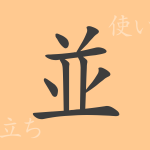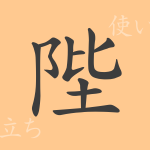Japanese culture is rich with symbols, and among them, “柄” (gara) is particularly multifaceted. From patterns on clothing to aspects of a person’s character, the breadth of meaning carried by this single character is astonishing. In this article, we will delve deep into 常用漢字 (jouyou kanji) “柄” (gara), exploring its etymology, modern usage, as well as its readings and stroke count, uncovering its captivating charm.
Origin of 柄 (Etymology)
The kanji “柄” (gara) has been used in Japan since ancient times. It is said to have originated from a pictograph representing the “柄” (gara) or handle of a tool. Over time, its meaning expanded to refer to a person’s nature or characteristics.
Meaning and Usage of 柄
“柄” (gara) carries several meanings and is used differently depending on the context. Generally, it refers to the handle of an object or patterns and designs. It is also used to describe a person’s character or demeanor. The expression “柄にもない” (gara ni mo nai) is used when someone acts in a way that is out of character or unsuitable for their usual nature or position.
Reading, Stroke Count, and Radical of 柄
“柄” (gara) has multiple readings in Japanese.
- Readings: In 音読み (on’yomi) it is read as “ヘイ” (hei), and in 訓読み (kun’yomi) it can be read as “え” (e) or “がら” (gara).
- Stroke count: The kanji “柄” (gara) consists of 9 strokes.
- Radical: The radical of this kanji is “木” (ki), categorizing it among kanji related to wood.
Idioms, Phrases, and Proverbs Using 柄
There are several idioms, phrases, and proverbs that include “柄” (gara).
- “柄にもない” (gara ni mo nai) – Refers to actions that are out of character or unsuitable for one’s usual nature.
- “柄に合う” (gara ni au) – Indicates something that is fitting for one’s character or position.
- “刀の柄を握る” (katana no tsuka wo nigiru) – An expression meaning to seize power.
- “柄にかかる” (gara ni kakaru) – Refers to something being influenced by a person’s character or traits.
Summary of 柄
The character “柄” (gara), used in various contexts in daily life, symbolizes the richness of the Japanese language. From the柄 (gara) of objects to aspects of a person’s character, it holds a wide range of meanings, playing an important role in each context. Through this article, we hope you can appreciate the diversity of “柄” (gara) and the history and culture behind it.

























